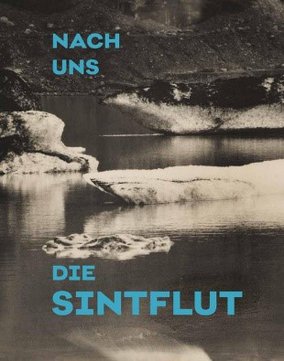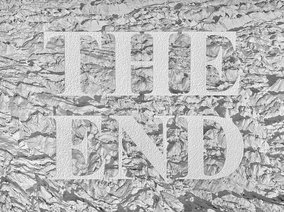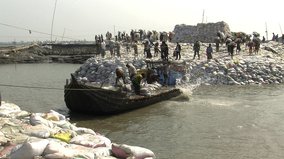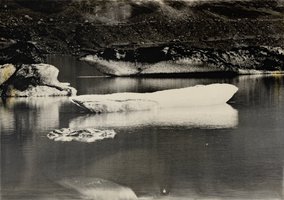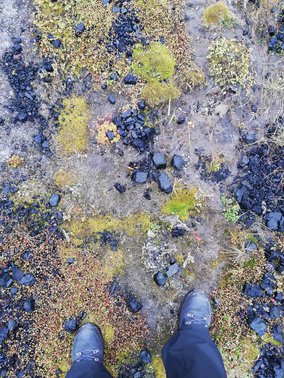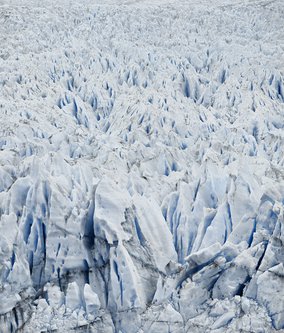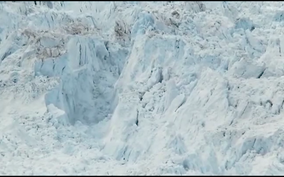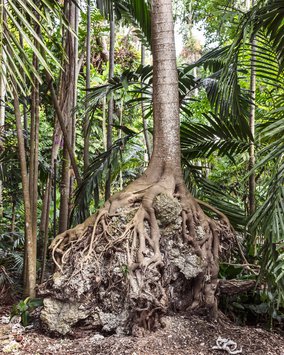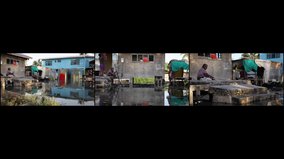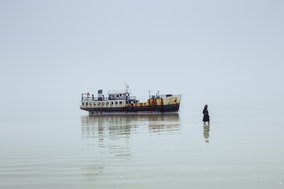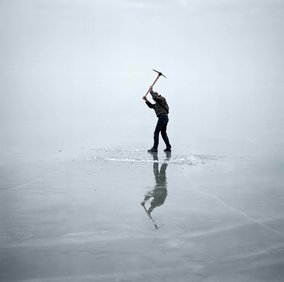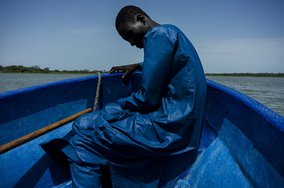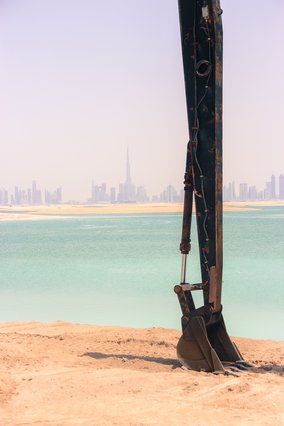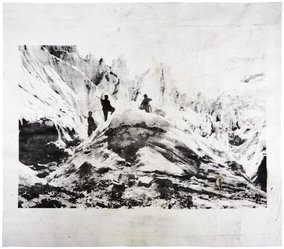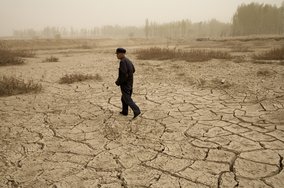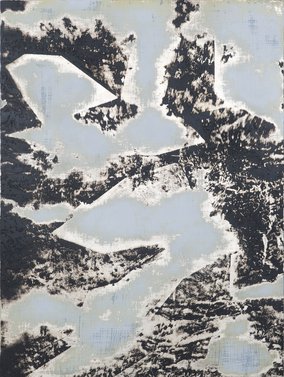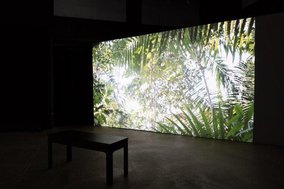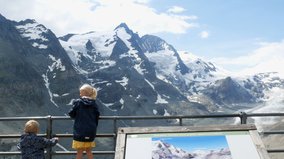After Us, the Flood
Après nous, le déluge (After us, the flood) denotes an attitude of indifference towards future developments, but also towards the negative repercussions of one’s behaviour on future generations. Karl Marx saw it as the maxim of capitalism: ‘Après moi le déluge! [After me, the flood!] is the watchword of every capitalist and of every capitalist nation,’ wrote Marx in 1867 in Das Kapital. Given the profit-driven exploitation of the planet and the indifference towards the de facto environmental havoc being wreaked by mankind, it is a watchword that seems particularly apposite as a diagnosis of our current situation. The exhibition seeks to bring the global climate crisis sharply into focus and highlight the urgency of the need for action. Indeed, alongside international scientific associations, environmental organisations and sociopolitical movements such as ‘Fridays for Future’, art is also part of a global alliance aimed at a fair and equitable economic reform mindful both of our planet’s resources and its climate as well as a more sustainable lifestyle. The twenty artistic positions brought together here showcase the negative consequences of unbridled capitalism for both humankind and nature; they also highlight the systemic connections at the heart of our global ecosystem.
Artists
Benoit Aquin, Ursula Biemann, Axel Braun, Solmaz Daryani, Verena Dengler, Michael Goldgruber, Justin Brice Guariglia, Stephan Huber, Genoveva Kriechbaum, Anouk Kruithof, Bénédicte Kurzen, Douglas Mandry, Benedikt Partenheimer, Sarker Protick, Gabriele Rothemann, Anastasia Samoylova, Christina Seely, Nicole Six & Paul Petritsch, Frank Thiel, Angela Tiatia
Curators
Sophie Haslinger and Verena Kaspar-Eisert
-
Exhibition Catalogue
After Us, The Flood
With a presentation of all the exhibited photographs and video works as well as comprehensive background information on the artists and works, the catalogue to Nach uns die Sintflut offers a broad overview of the exhibition. More -
Justin Brice Guariglia
The End
The letters carved out of the white surface form into a monumental unambiguous statement: The End. Justin Brice Guariglia’s largeformat work The End (2019) punctuates the starting point of the exhibition tour. More -
Ursula Biemann
Deep Weather
In her video essay Deep Weather (2013), Swiss artist Ursula Biemann exposes the consequences of the relentless search for fossil fuels for distant regions of the world and their inhabitants. She makes manifest the correlation between the havoc wreaked by tar sand exploitation in Canada and the problems faced by the population living in low-lying Bangladesh due to rising sea levels. More -
Benedikt Partenheimer
Memories of the Future
For his series Memories of the Future (2017), Benedikt Partenheimer travelled to Alaska to study the impact of global warming on the permafrost through photography. The two photographs Methane Experiment show flames that the artist lit at a methane gas bubble that had formed beneath the ice of a frozen lake. More -
Gabriele Rothemann
MINIATUREN ÜBER DAS VERSCHWINDEN
In autumn 2019, artist Gabriele Rothemann travelled to Iceland to Sólheimajökull, a glacier tongue in the south of the island nation, and photographed the almost monochrome landscape there. More -
Verena Dengler
Dr. Envy Nordpol besucht das nördlichste Sushi-Restaurant der Welt
Every year, people from all over the world are drawn to the Svalbard archipelago in the Arctic Ocean, driven by a longing for glaciers, fjords, polar bears, and the northern lights. In the summer of 2018, Verena Dengler also undertook a journey to the island group located north of the Arctic Circle. More -
Frank Thiel
Perito Moreno
Frank Thiel’s photographic work Perito Moreno (2012–2013) is characterised by an aesthetic and content-based interest in structures and architectures that are shaped by human civilisation and culture, and similarly charged with meaning. With these photographs, Thiel has erected a sort of photographic monument to glaciers of the Argentine part of the South Patagonian Ice Field. More -
Anouk Kruithof
Ice Cry Baby
Ice Cry Baby (2017) is a found-footage collage comprised of YouTube videos of calving and melting glaciers captured by tourists and shared on the video channel. The emphasis is on the spectacular nature of the process and the desire to share something sensational, not least in the hope that the aura of the exceptional will rub off on the originator, too. More -
Anastasia Samoylova
FLOODZONE
In her artistic practice, Anastasia Samoylova moves between observational photography, studio practice and installation. With her works, the Russian-American artist explores concepts of environmentalism, consumerism and the picturesque. More -
Angela Tiatia
TUVALU
Angela Tiatia’s video work Tuvalu (2016) captures the everyday life of the inhabitants of Funafuti, the main island of the island state of Tuvalu, from the cockerel’s first crowing right through to the sun setting. More -
Solmaz Daryani
The Eyes of Death
Solmaz Daryani’s long-term photographic project The Eyes of the Earth – The Death of Lake Urmia (since 2014) depicts the severe ecological and social changes resulting from the drying up of Lake Urmia in her native Iran. The lake in the north-western corner of the country was once the largest salt lake in the Middle East. More -
Nicole Six & Paul Petritsch
RÄUMLICHE MASSNAHME
In the video work Räumliche Massnahme by the artist duo Nicole Six & Paul Petritsch, we as viewers witness a deliberate disappearance. Undeterred, a man stands on the ice surface, digs a hole and takes out his pickaxe again and again and will - one soon suspects - pull the ground out from under his feet. More -
Michael Goldgruber
Talschluss
The wall installation, some 10 m in length, features photographs of the Gepatschferner. Situated to the south, above the Kaunertal valley, the Gepatschferner is Austria’s second largest glacier and one of the fastest melting. Indeed, over the past ten years, the glacier tongue has shrunk by 700 m. More -
Bénédicte Kurzen
LAKE CHAD CHRONICLES
For many years now the photographer Bénédicte Kurzen has been looking at power relations in post-colonial African states, which are characterised by conflicts and huge socio-economic upheavals. More -
Genoveva Kriechbaum
The World / The Heart of Europe
The World is a man-made archipelago comprised of some 300 islands. As of 2003, 34 billion tonnes of rock and 320 million cubic metres of sand were piled up into the sea over an area of several square kilometres, 4 km off the coast of Dubai. By 2008, the ‘construction’ of these islands had been completed, but the economic crisis that followed initially brought the project to a standstill. More -
Douglas Mandry
MONUMENTS
In his Monuments (2018) series the Swiss artist and photographer experimented with used glacier fleece from the Gurschenfirn in the Andermatt-Gemsstock area and used it as a photographic image medium. Mandry then printed the fleece, which still bore the distinct traces of its previous use on the ice surface, with photographs of glacier regions from the early 20th century. More -
Sarker Protick
Of River and Lost Lands
Since 2011 Bangladeshi artist Sarker Protick took photographs along his home country's largest waterway. These quiet and tranquil photographs, like the video work Monsoon, for which the artist also composed a soundtrack, are imbued with a melancholy mood. More -
Stephan Huber
The Empire Strikes Back
Maps have served as a means of orientation since time immemorial, revealing contexts and correlations that may not be visible from any of the perspectives available in the original space. But finding our way around Stephan Huber’s fictitious large-format topographies – something the artist has been working on since the 1990s – is no easy task, for they open up a fantastical associative cosmos. More -
Benoit Aquin
The Chinese Dust Bowl
In his series The Chinese Dust Bowl (2006–2009) Benoit Aquin documents the desertification of vast areas of land in China and its impact on the local population. The extreme droughts in northern China and Inner Mongolia are certainly among the greatest environmental disasters of our time, and they are due to global warming and mankind’s ecologically harmful activities. More -
Justin Brice Guariglia
Agricultural Landscapes
In his works, Guariglia commits to an objective and holistic approach in order to visualise the climate crisis as a global phenomenon. His artworks are often created in intensive collaboration with scientists and philosophers. More -
Christina Seely
TERRA SYSTEMA. TEMPO
With Terra Systema. Tempo (2017) we as viewers find ourselves at the very heart of an audiovisual dialogue between ecosystems both Arctic and tropical, symbolising the Earth’s power of self-renewal. Through her photographic work, Christina Seely creates a connection between scientific data and emotions and makes us aware of the fragility of nature. More -
Axel Braun
Records of Loss
Axel Braun has dedicated his latest project, Records of Loss (2019–2020), to Austria’s largest glacier, the Pasterze, at the foot of the Grossglockner [Austria’s highest mountain]. From his extensive research the artist has retraced the history of illustrations of this valley glacier. More

